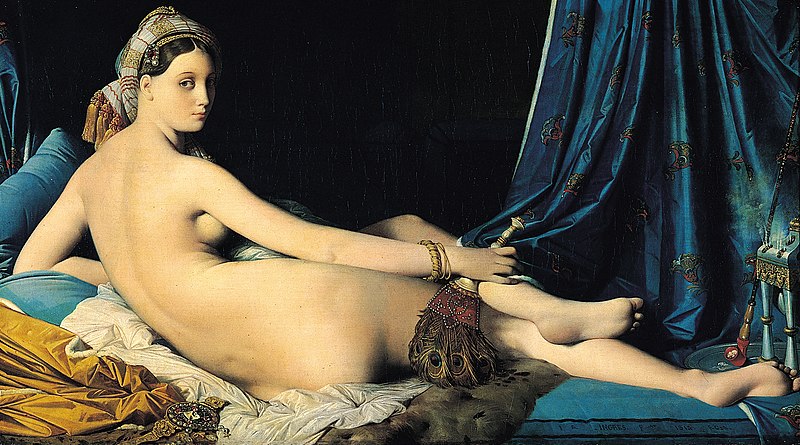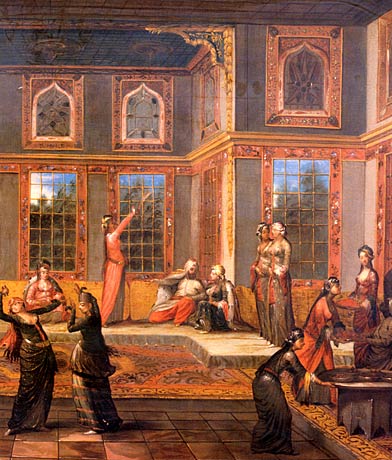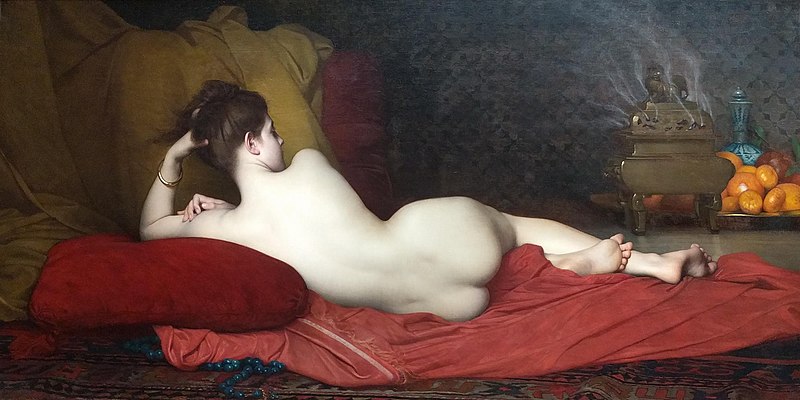Today’s post is a bit, well, risque, so if you’re offended by art depicting nude women, I suggest you click away now. Also, I am NOT an art historian. The commentary is all mine and surely lacks any professional insights that would make this more coherent and detailed. But that never stopped me from forming an opinion!
Nevertheless, I think it’s quite plain that these paintings say more about the painter and the targeted observer than they do about life in a harem at any time. One can certainly extrapolate — women sequestered from men, expected to sexually service a single man. For the European man whose religion officially limited him to one wife and, culturally, to a single mistress, the thought of having a (cough) harem of women in service to him at his very male whims, must have been quite beyond titillating. I have no doubt some men disapproved. But the paintings suggest a good many were fascinated…
These women are all youthful, I found no pictorial mention of women who had lived past the state of desirability. And the majority of men with harems did not have a whole city of woman at their beck and call — they were perhaps a few women, but I suspect it depended upon the man’s rank and wealth. The Sultan was another matter; he did have thousands of women in the Seraglio.
From all the accounts I read, Caucasian women were preferred for the harems. There seems to have been some discomfort about what was, in effect, the sexual slavery of social cohorts. Slavery is for Others, after all. Turks and Arabs routinely raided Eastern Europe and into Spain for women to sell. This “White Slavery” did stop, officially, by the very late 1700’s.

You’ll notice that this Ingres painting features two extremely pale women. The servant standing in the background is dark skinned and, in this image, not identifiable as female. If this is a man, he is a eunuch. And since he is in the presence of women, his penis has been removed entirely. Eunuchs who worked in the harem but outside the women’s quarters had their testicles removed or damaged beyond fertility but retained, generally, the rest of the package. Note, too, that the more naked the woman, the paler the skin. What does that suggest about notions of what and who was sexually desirable? Is there some racial anxiety here?
Of course, this is not a real Odalisque. Again, note the pale, European skin. A real Odalisque would have been a servant. European notions of the harem, and anxieties, not completely unfounded, about Caucasian women in the harem, about women and their sexuality are subtly expressed here. Remember, this is not a factual depiction, but rather a depiction of the European conception of Caucasian women whose sole purpose was the sexual pleasure of a man.

A very famous Ingres painting I’m sure you all recognize. Same remarks as above.

This painting shows a gentleman being entertained by the ladies in his harem. He is seated in the right corner of the divan, this was the place of honor, as it were. Servants and lower ranking individuals would not be permitted on the divan, they would sit on the floor. He is as you can see, with (presumably) his favorite at his side whilst he is entertained by other women. There are some quite lovely architectural and furniture details — the divan, which runs the perimeter of the room, the high windows and beautiful scroll work and filigrees. The table to the right is quite authentic as well.
This sketch shows the interior of the Seraglio. They had to be efficient in order to house so many women!

Ah, one can just imagine the Sultan being entertained by his very accomplished concubines. To the right is a fountain, very much like you’d see in one of the baths.
This woman (again, note that the naked woman is very pale, the servant is not…) is in the hammam, the Turkish bath. She is wearing pattens on her feet so she doesn’t fall and break her neck. European notions of rank, sexuality and desirability once again in full display.

Lest you come away thinking that all the woman painted as members of a harem were white, they weren’t. Here’s a woman of color. Though I feel compelled to note she is arranged in an inferior position, with the paler woman plainly the focus. After looking a dozens of such pictures the commonality was pretty obvious.
The women are typically depicted as sitting around with nothing much to do but wait for the Male (and not any old male, but The Male to have sex with her.) Again, this says more about the state of mind of the (male) painter than it does about actual life in the harem.




I find the Orientalists’ art visually gorgeous, but probably historically incorrect. But the paintings are hard to resist. Thanks for a beautiful wake-up.
Yes, you’re right. Very inaccurate, but lush and beautiful. And, really, a nice commentary on the state of mind of the European man.
Very interesting, Carolyn.
I must say, the harem is not my fantasy, but I can certainly see how it would be a man’s.
The paintings are beautiful.
I read a really interesting book on just this subject written by Moroccan sociologist Fatima Mernissi. She talks about the differences between the ‘harem’ she grew up in and the Western focus on the harem. It’s called ‘Scheherezade Goes West’, if you’re interested.
I, too, love the art, but I had never thought of the racial issues, thanks!
When I was a little girl I had a harem outfit I wore all the time. Of course it looked nothing like these and my 8-year-old body was covered, but now that I read about how women were treated I wonder “Why would I ever want to dress like a harem girl?” I must have really like the veils. Plus it was purple and that is my signature color.
Carolyn, I love you.
Thank you, thank you, thank you!!!!
Great post.
My husband and I were in Istanbul last month and visited the harem in Topkapi Palace. Our guide said that harem is the private part of the house, meant just for the family and servants, and does not have the sexual connotations placed on it by Western visitors. However, I can see how Western men would be intrigued by a place where the women were hidden away and impute all sorts of meaning to this secret place. Several of the rooms looked very much like the one in the painting of the man on the divan with his favorite by his side. Topkapi, and Istanbul itself, is filled with beautiful, beautiful buildings and rooms and art, both modern and ancient.
As to the source of the women, our guide said that most weren’t Muslim when captured or given as gifts because it was against the religion. It is thought that one of the most famous, Roxelana, came from the Ukraine.
I didn’t realize that the eunuchs who went among the women were so mutilated. Many must have died of the surgery, or later of infections.
The paintings I think are very beautiful.
I am not sure that I would have liked to have living in a harem though.
Have Fun
Helen
Gorgeous paintings, Carolyn. And an interesting look at the perceptions of beauty held in the minds of the painters and perhaps in the minds of those who ruled over the harems.
I know I wouldn’t like being a member of a harem. I don’t share very well!!
Thanks for all the great comments!
@Lana, I’ll have to look for that book, it sounds very interesting.
@susan/DC I so want to go to Turkey! And yes, the harem was family quarters and not the guarded prison as was, in effect, the Seraglio, but Ottoman women were still quite restricted.
Non-muslim women who were captured were, from what I’ve read, forced to convert to Islam. There is period Elizabethan English Literature (blanking on the name right now) that features pirates, English and Ottoman, and forced conversions to Islam. I read that play in grad school, it was quite interesting. There are reports that some Englishmen/pirates in Tudor times, converted to Islam in order to gain protection from the Ottomans against English privateers.
The descriptions of eunuchs related to those who worked at the Seraglio, though it was fairly evident that castration took place in larger harems as well. But most harems were quite small.
@Aztec Lady: LOL! I love you too!
[…] collectors group. For Indiscreet, I had to go big and wide — Turkey in the Regency era. One of my first posts (possibly NSFW, as the post has naked women paintings) for the Riskies was the result of some of […]